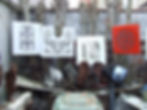
SEALS

Wong Wa's worlds is a world of sculpture, playing with lines in space, with his sculptures-writings. Plastic space revealed by torn, cut paper. Plastic space again created with his series of masks. Lines of paper drawn by the painter's brush or the calligraphist's. Lines carved in the seals' tender stone.
The carving art joined in time calligraphy, painting and traditional chinese poetry to form the four pillars of China Fine Arts. It has been one of the first techniques of reproduction of writing, since 1500 BC.
Seals are handcarved. Through the technique of sculpture, they combine the beauty of Chinese ideograms with the drawing of lines. They were once used to authentificate official documents. By reproducing the same picture no matter how many times they were used, they can be considered the precursors of one the greatest Chinese inventions : printing.








The most important part of the seal sculpture is the carving of the surface who will be affixed on the paper for instance. At that moment come into place the agility and technique of the carver, but also the distribution in space of writing, an art of equilibrium. The full and the empty, the Yin and the Yang.
The work of a carver is as aknowledgeable as the signature of western painters. Worshiped art in China, it is still taught today as part of Fine Arts.

